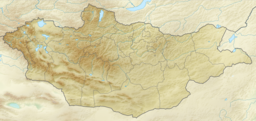| Khar-Us Lake | |
|---|---|
 Khar-Us Lake frozen, Khar Lake fragment is at the western edge of the image, Jargalant-Khaikhan Mounts are south from Lake Khar-Us (NASA astronauts image 2002-12-13). | |
| Location | Khovd aimag, Mongolia |
| Coordinates | 48°02′N 92°17′E / 48.033°N 92.283°E |
| Type | freshwater |
| Primary inflows | Khovd River |
| Primary outflows | Chono Kharaikh gol |
| Catchment area | 74,500 km2 (28,800 sq mi) |
| Basin countries | Mongolia |
| Max. length | 72.2 km (44.9 mi) |
| Max. width | 36.5 km (22.7 mi) |
| Surface area | 1,578 km2 (609 sq mi) |
| Average depth | 2.2 m (7 ft 3 in) |
| Max. depth | 4.5 m (15 ft) |
| Water volume | 3.432 km3 (2,782,000 acre⋅ft) |
| Surface elevation | 1,156.7 m (3,795 ft) |
| Frozen | November - April |
| Islands | Agbash (Ak-Bashi) |
| Settlements | Dörgön |
| Designated | 13 April 1999 |
| Part of | Har Us Nuur National Park |
Khar-Us Lake (Mongolian: Хар-Ус нуур, romanized: Har-Us nuur; ᠬᠠᠷᠠᠤᠰᠤᠨᠠᠭᠤᠷ, "Black-Aqua Lake", is a lake in western Mongolia in the Great Lakes Depression. It is the upper one in a system of the interconnected lakes: Khar-Us, Khar, Dörgön, Airag and Khyargas. The lake is located in Har Us Nuur National Park.
Its area value (1,852 km2) includes the island Agbash (or Ak-Bashi, white head) area (274 km2), so the water surface area is 1,578 km2 only.[1]
Some sources are using different Khar-Us Lake Lake statistics values:[2]
- Water level: 1,160.08 m
- Surface area: 1,496.6 km2
- Average depth: 2.1 m
- Volume: 3.12 km3.
| Surface input | Surface output | Groundwater inflow- outflow |
Retention time, years | ||
|---|---|---|---|---|---|
| Precipitation | Inflow | Evaporation | Outflow | ||
| 56.4 | 1,979.2 | 942.7 | 675.3 | -417.6 | 1.1 |
Primary inflow is the Khovd River, which creates a large river delta.
So called Genghis Khan's wall runs along the western shore of the Khar-Us Lake. It is possible to find it at the Google Map and Google Earth satellite maps 47°53′29″N 91°59′37″E / 47.89139°N 91.99361°E.
References
[edit]

Well, that’s interesting to know that Psilotum nudum are known as whisk ferns. Psilotum nudum is the commoner species of the two. While the P. flaccidum is a rare species and is found in the tropical islands. Both the species are usually epiphytic in habit and grow upon tree ferns. These species may also be terrestrial and grow in humus or in the crevices of the rocks.
View the detailed Guide of Psilotum nudum: Detailed Study Of Psilotum Nudum (Whisk Fern), Classification, Anatomy, Reproduction